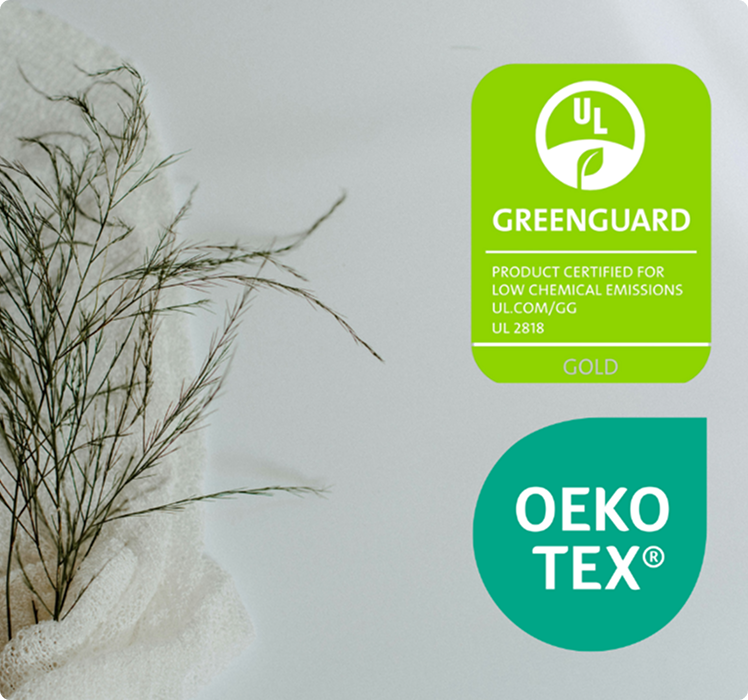Products That Get the Greenguard Seal of Approval
From the mattress you snooze on to the furniture you lounge on, Greenguard certification spans across:
Furniture:
Chairs, tables, cribs, you name it. If it’s for seating or storage, there’s a good chance it can get certified.
Building Materials:
Think about your walls, floors, ceilings — materials like paint, adhesives, and insulation can all carry this certification.
Electronics:
Your gadgets, from computers to TVs, can be tested to make sure they’re not secretly polluting your air.
Flooring:
Whether it’s carpet, hardwood, or vinyl, if it’s underfoot, it could be Greenguard certified.
Mattresses and Bedding:
A good night’s sleep shouldn’t come with a side of chemical exposure, right?
And the list doesn’t stop there; even office supplies and cleaning products can join the Greenguard gang.
How Do Products Earn This Title?
Becoming Greenguard Certified is a process:
Testing:
Products are placed in controlled chambers where their emissions are measured over time. They’re checked against thousands of chemicals, primarily focusing on VOCs, formaldehyde, and phthalates.
Standards:
There are two main tiers:
Greenguard Certified:
For general indoor environments, products must meet set emission limits.
Greenguard Gold Certified:
This is the VIP level, with even stricter limits, especially designed for places like schools and healthcare facilities where the young, elderly, or sensitive individuals spend time.
Retesting:
Certification isn’t a one-and-done deal. Products are retested annually to keep that certification valid, ensuring they continue to meet the standards.
What’s Oeko-Tex All About?
Now, let’s jump more strictly into the world of textiles. Oeko-Tex Certification is the textile industry’s promise to keep you safe from harmful substances in everything you wear or use:
Oeko-Tex Standard 100:
This is the most recognized, ensuring textiles are free from over 1,000 harmful substances. From buttons to zippers, if it’s part of your fabric, it gets tested.
Oeko-Tex Made in Green:
Goes beyond just safety, adding transparency in the supply chain, ensuring sustainable and socially responsible production.
Oeko-Tex Step:
Certifies manufacturing facilities for environmentally friendly practices.
The Million-Dollar Question: Are These Certifications Totally Non-Toxic?
Both Greenguard and Oeko-Tex certifications are great places to start when thinking about your health, but they don’t ensure that a product is 100% non-toxic. Here’s the deal:
Greenguard Focus:
Greenguard tests for emissions, not for what’s inherently in the product. So, if there are toxic materials that don’t off-gas significantly, they might not be flagged.
Oeko-Tex Scope:
Oeko-Tex ensures textiles are free from harmful substances, but doesn’t cover every possible hazard or environmental impact of production.
Complementary Certifications:
For a fuller picture, consider combining these with other certifications like CertiPUR-US for foams, which look at different aspects of safety.
The Cost of Going Green
Manufacturers interested in securing these logos on their products have to be prepared for some investments:
Greenguard Application Fees:
Starting at around $5,000, with additional testing costs that can run into thousands or even tens of thousands, depending on product complexity.
Oeko-Tex Costs:
Varies by standard, but expect initial testing fees, annual certification fees, and sometimes costs for facility audits. For instance, Oeko-Tex Standard 100 can start from a few hundred euros for simple products to much higher for complex ones.
Annual Fees:
Both require ongoing fees to maintain certification status, ensuring products continue to meet standards.
All that to say, obtaining these certifications may be out of reach for smaller or new companies. And in the same way that Greenguard and Oeko-Tex certifications can’t guarantee that products are completely non-toxic, a lack of certification surely doesn’t mean that a product is toxic either.
Nevertheless, looking for Greenguard and Oeko-Tex certifications is a helpful step towards reducing your exposure to harmful substances.

